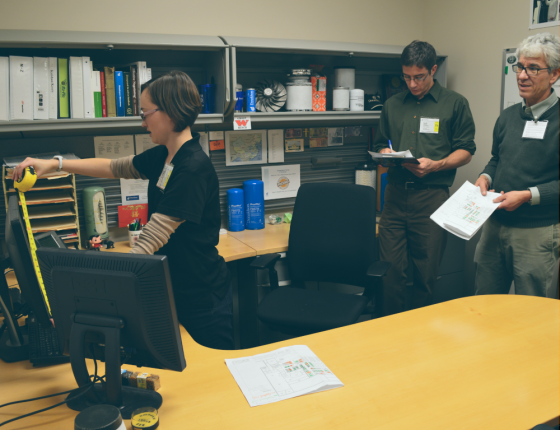Plug load is the fastest growing energy use in U.S. commercial buildings, in stark contrast to decreases in other end uses such as cooling and lighting. Plug load is the energy used by products that are powered by means of a standard electrical plug, which includes everything from computers to water coolers. This project characterized commercial building plug load energy use and evaluated reduction strategies through control technologies and occupant behavior strategies.
Approach
The project team characterized 34 offices in Minnesota, looking at both workstations and common area equipment, before selecting a sample of eight for further field data collection. The team then collected baseline data and implemented energy reduction strategies at those eight offices. After the strategies were implemented, the team collected more data and surveyed occupants to gauge their satisfaction. The following strategies were tested, each separately:
- Advanced power strips with an occupancy sensor
- Advanced power strips with a foot pedal (also included a timer)
- Computer power management
- Behavior campaign including feedback, rewards, and information
- Timers on common area equipment
Results
Energy Savings
The table below shows the average energy savings for each workstation reduction strategy. (Note: not every site received every strategy, so this table is does not provide direct comparison between the strategies.)
| Strategy | kWh per station | % (with 95% conf. int.) | N |
| APS/occupancy Sensor | 67 | 21.7% ±14% | 95 |
| Computer power management | 106 | 29.1% ±18% | 116 |
| APS/foot pedal | 42 | 19.0% ±13% | 74 |
| APS/foot pedal + behav. campaign | 70 | 22.4% ±13% | 48 |
Computer power management saved an average of 106 kWh, or 29% of average workstation energy. The two advanced power strip measures saved between 42 and 67 kWh, or 19% and 22%, respectively.
The behavior campaign was implemented at two sites and built on the advanced power strips with foot pedal. As a part of the campaign, the advanced power strips were left in place to help users to save additional energy by changing their behavior. The result was an increase in energy savings of 50 kWh.
Economics
The cost of implementing the plug load reduction strategies used in this study was between $17 and $55 per installation. The team used life-cycle cost analysis to determine the cost effectiveness of each strategy, using break-even cost (the cost at which the installation makes financial sense) as a key metric. The break-even cost for computer power management was at the high end at $143 per workstation. The break-even cost for timers on common area equipment was also on the high end at $66-144 per instance, depending on device. Simple payback for these measures was two to four years. Advanced power strip strategies are likely cost effective in many situations, with a break-even cost close to $75. Simple payback for the advanced power strips is about eight years and the payback drops to five years with a typical utility incentive of $20 per device.
Participant Satisfaction
The survey of research participants showed that the advanced power strip with foot pedal was the most widely accepted of the strategies tested. The occupancy sensor was noticeably less popular, likely because it did not have the control that came with the foot pedal. The satisfaction with computer power management varied widely, with an average of 70% of participants responding positively (see the figure below).
Workstation plug load strategy survey responses

Recommendations
Recommendations for addressing plug load in Minnesota’s Conservation Improvement Program include:
- Provide incentives and technical support to increase adoption of computer power management.
- Provide incentives and assistance to increase adoption of simple controls, especially advanced power strips with appropriate user interaction and simple device timers.
- Develop a strong relationship with IT departments to facilitate offerings.
- Consider more innovative program approaches that go beyond basic incentives such as direct install, behavioral, targeted outreach, and upstream offerings.
- Integrate simple plug load reduction strategies into more holistic programs like retrocommissioning, turnkey small business, and new construction.
- Include messaging targeted toward users in all program offerings.
Final Report
Project Summary
Objective
Characterize commercial building plug load and develop accurate energy use measurement and assess plug load reduction strategies.
Scope
Survey 30 to 50 buildings/offices for plug-load characterization and select 8-12 buildings/offices for year long plug-load reduction study.
Non-energy benefits
Researchers provided design teams, owners, and financial decision-makers with economic and occupant acceptance analyses related to the plug load strategies.
